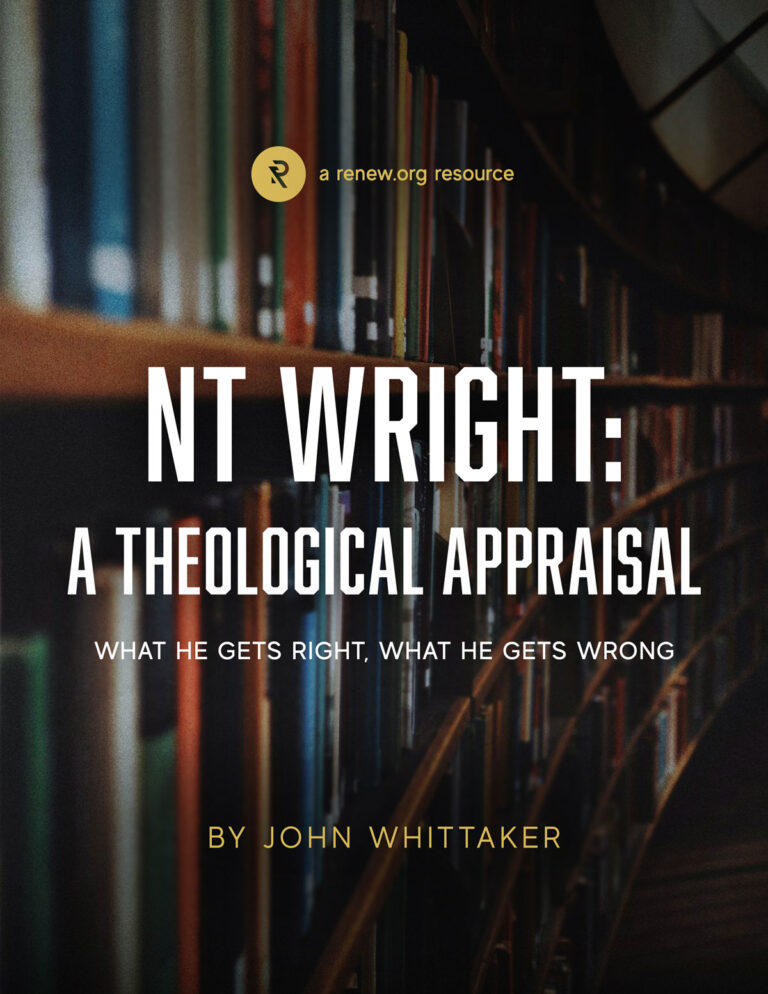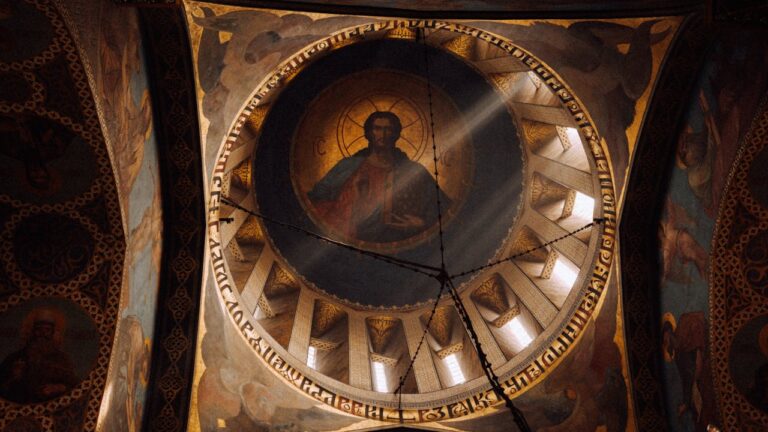The Book of Enoch is perhaps one of the most widely known pieces of literature from the corpus known as the Old Testament Pseudepigrapha. It purports to be the work of Enoch, seventh in the line from Adam (on Seth’s side), though some of it is supposedly also written by Noah.
When you are asked about the book of Enoch, you should clarify which one, as there is a 1 Enoch, 2 Enoch (the “Apocalypse of Enoch”), and 3 Enoch.
This article explores 1 Enoch, which is the book usually meant by “Book of Enoch.” 1 Enoch expounds on several key passages from the Old Testament. First, of course, is the brief account of Enoch in Genesis 5:21-25. Second is the mysterious “Sons of God and the Daughters of Men” passage in Genesis 6:1-4. Third is the Daniel 7:13-14 passage which describes the Son of Man figure. Most of the interest in this book seems to be centered on fallen angels and the Son of Man figure.
The Book of Enoch Throughout Church History
The existence of the book of Enoch was known by many of the church fathers such as Irenaeus (A.D. 180) and Tertullian (A.D. 200). Many, but not all, had a favorable view of the book and at least some may have considered it canonical.
However, the complete text of the book was lost to the Western world until early in the seventeenth century when it was discovered that several copies of the book existed in the Ge’ez dialect of Ethiopic within the Ethiopian church. This is the only branch of Christianity that officially considers the book canonical. It would not be available to English readers until its translation in the nineteenth century.
This Ethiopic version was likely translated from a Greek copy, although the book was likely originally written in Aramaic or Hebrew. Among the Dead Sea Scrolls discovered at Qumran, in cave 4, there were several fragments of Enoch found in Aramaic, from about eleven total scrolls.
Basic Structure of the Book of Enoch
1 Enoch is a composite of five different books written over a few hundred years. The earliest pieces date to the fourth century B.C. while the latest pieces (Book 2 usually) might date to the first century B.C. to the first century A.D. Obviously, this is much later than the biblical Enoch or Noah so this work is what would be labelled as pseudonymous.
The first book is known as the “Book of the Watchers.” This book is divided into chapters 1-36 and was likely written in the third century B.C. This book deals mostly with fallen angels and Enoch’s otherworldly journeys.
The second book is the “Book of Parables,” sometimes known as the “Similitudes of Enoch.” It is divided into chapters 37-71 and features visions concerning a Son of Man figure who will deliver the righteous. It is the only part of the book that is found in no manuscripts from the Dead Sea Scrolls.
The third book, often called the “Book of Luminaries” or “the “Astronomical Book” is usually considered the oldest of the books, dating to the fourth century B.C. It discusses celestial motions and lunar and solar years. It is divided into chapters 72-82.
The fourth book, often called “the Book of Dreams” or “the Book of Dream Visions,” is a collection of two dream sequences which predict the flood and human history through at least the Maccabean period, though some say up to Herod the Great. It stretches from chapters 83-90.
The fifth book, often called the “Epistle of Enoch,” is itself divided into five sections. It is divided into chapters 91 to 107 and includes some basic exhortations to the righteous as well as a miraculous account of the birth of Noah.
“1 Enoch is a composite of five different books written over a few hundred years.”
The Book of Enoch and Canonicity
Today, only the Ethiopian church counts the book of Enoch amongst the Canon of Scripture. They actually have the largest canon, containing 84 books.
Historically, there is no real evidence that the Jews believed the book was part of its Canon. 1 Maccabees 9:27 states that the prophets had ceased from Israel by its time. The Tosefta (A.D. 200), a supplement to the Mishnah, states in Sotah 13:3-4 that the Holy Spirit had ceased from Israel after the deaths of Haggai, Zechariah, and Malachi. The idea was that, without a prophet or a prophetically inspired person, no authoritative Scripture can be written.
The Babylonian Talmud (about A.D. 600) in its listing of the books of the Bible (Babra Bathra 15) does not include Enoch. If Jesus thought it was Scripture, He makes no recorded statement to this effect. The apostle Paul, educated at the feet of the great rabbi Gamaliel, makes no reference to the book either.
What does help the case of Enoch (1 Enoch 1:9) being part of the Canon is a quotation of it in Jude 14-15 and the testimony of the early church fathers of the first-third centuries A.D. The quotation in Jude is as follows:
“Enoch, the seventh from Adam, prophesied about them: ‘See, the Lord is coming with thousands upon thousands of his holy ones to judge everyone, and to convict all of them of all the ungodly acts they have committed in their ungodliness, and of all the defiant words ungodly sinners have spoken against him.’” (Jude 1:14-15, NIV)
“Today, only the Ethiopian church counts the book of Enoch amongst the Canon of Scripture.”
However, the quotation by Jude does not necessitate that Enoch is Scripture any more than Paul quoting Epimenides the Cretan in Titus 1:12 makes the Greek playwright Scripture. Scripture itself references some books that are not part of the Canon, like the book of Jashar (see Joshua 10:13) and the book of the Wars of the LORD. This quotation does not have the “Scripture formula” such as “it is written” or “in order to fulfill.”
As for the early church fathers, several such as Irenaeus, Tertullian, and Origen (all late second to early third century A.D.) quote the book. Perhaps the earliest evidence that some considered the book Scripture is the author of Epistle of Barnabas (late first to early second century A.D.) who quotes Enoch and calls it Scripture.
However, Enoch is missing from the Muratorian Fragment (estimated at A.D. 180), Codex Vaticanus (A.D. 325), and the Festival letter of Athanasius (A.D. 367). It seems that, other than in Ethiopia, support for Enoch waned by the third century A.D. and the book was not included in Christian canons.
Summary of the Book of Enoch
Book 1: Book of the Watchers
The first part of the book, the Book of the Watchers, focuses on the fall of some twenty named angels who come together and make an oath to go and take some of the daughters of men as wives. Some believe that there are two versions to this tale, one in which Shemihazah is the leader who taught women magic and birthed giants, the other which focuses on Azazel who taught weapons of war. The offspring are giants who cause great grief to mankind by eating all the food, then eating humans, and finally eating each other.
The LORD of Spirits (God) then sends angels such as Michael, Gabriel, Raphael, and Uriel to capture these fallen angels and lock them away in a place for the final judgment. These angels beg Enoch to intercede for them to God, but God is unwilling to listen. As punishment, these angels are forced to watch as their offspring start fighting with one another, ultimately wiping each other out.
The rest of the book of the Watchers narrates angels giving Enoch a tour of both earthly places and heavenly places, including the places where the fallen angels are kept while they await the final judgment.
“The first part of the book, the Book of the Watchers, focuses on the fall of some twenty named angels who come together and make an oath to go and take some of the daughters of men as wives.”
Book 2: Book of Parables
The second book, the book of the Parables, is likely the most recent of the sections of Enoch, with possible allusions to even Herod the Great, making most scholars date its composition to late first century BC or early first century A.D. Again, no part of this section of Enoch was found at Qumran, and it may have been unknown to this community due to its late date of composition.
The first of these parables (narrated in chapters 37 to 44) shows Enoch receiving revelation from the LORD of Spirits and being led by angels to the place where the righteous will dwell. There, he sees some the blessings that await them. He also sees the place reserved for the final judgment of the wicked.
The second parable (chapters 45-57) focuses on the last judgment and, in particular, on the figure of the Son of Man as mentioned in Daniel 7. Enoch reveals that this Son of Man was named before even creation. Elements of Psalm 2 also come into play as those who have rebelled against the throne and against the Son of Man are dismayed at the Son of Man’s sitting on the throne.
The third parable continues the theme of judgment for the wicked and life for the righteous. The wicked beg for mercy from the Son of Man, but the Son of Man refuses, judging them for what they had done to God’s children. The righteous will live forever with the Son of Man. Several chapters in this parable focus on Noah rather than Enoch as it references his “five hundredth year” whereas Enoch walked this earth for only 365 years. The Flood is given extended treatment in the form of a book Enoch gives to his great grandson.
“The wicked beg for mercy from the Son of Man, but the Son of Man refuses, judging them for what they had done to God’s children.”
Book 3: Astronomical Book
The “Astronomical Book” or “Book of Luminaries” is well attested at Qumran with four copies. This book is related to Enoch by the angel Uriel (whose name means “My God is Light”). This book concerns itself with describing the years, both the lunar one and the solar one (which they count as 364 days). Since Enoch’s lifespan was 365 years on earth, this may be why the book of Enoch has this section.
Book 4: Book of Dreams
The fourth book is a book on dreams, and in the first one (chapters 83-84), Enoch relates to his son Methuselah a cataclysm of the heavens crashing to earth and the whole world sinking into the abyss. Most understand this to be a reference to the Flood.
The second dream is known as the “Animal Apocalypse.” It basically gives the history of God’s people from the beginning at least through Judas the Maccabee (approx. 160 B.C.), but is a history in which the people are pictured as animals. In the beginning, the chosen line are white cattle with the others being black or red.
Here, the history of the angels cohabiting with human women is related again. Noah’s boys are bulls of three different colors, and these bulls have children of a variety of wild animals (such as goats and pigs) and birds such as ravens. Once we get to Jacob, the animals change from cattle to sheep. Other nations like Egypt are pictured as wolves.
Once the monarchy comes into play, individuals like Saul and David are pictured as rams. The decline of the monarchy is depicted when seventy shepherds (like the traditional seventy nations of the world as listed in Genesis 10) are used to discipline the flock. Toward the end of this period, some white lambs are born that try to get the flock to turn back to the LORD.
Finally, a large ram with a single horn (Judas the Maccabee) arises, and God strikes the earth. The final judgment then seems to take place with Azazel, the other fallen angels, and the seventy nations being cast into the fire.
“Enoch relates to his son Methuselah a cataclysm of the heavens crashing to earth and the whole world sinking into the abyss. Most understand this to be a reference to the Flood.”
Book 5: Epistle of Enoch
The fifth portion of the book of Enoch, known as the Epistle of Enoch, begins with the mysterious “Apocalypse of the Weeks” where Enoch relates all human history to Methusaleh in the form of “weeks.”
This book seems the most difficult to define in terms of genre, but most classify it as something “wisdom-like.” It spends most of its time discussing the plight of the righteous and the seeming triumph of the wicked in this life. It also focuses on a debate as to whether there will be a final judgment.
The last three chapters are a bit unusual, and the people at Qumran noted this as they drew a line after chapter 105 and left a blank space before starting chapter 106. Chapters 106-107 focus on the birth of Noah. The boy had such remarkable features that Lamech, his father, feared that Noah wasn’t his child and that his wife had lain with a Watcher (angel).
Lamech asked his father Methuselah to seek out Enoch (Methuselah’s father) for the answer. Enoch replied that the child was indeed Lamech’s and that the child’s unusual appearance suggested that God was going to do something wondrous in his life. The final chapter (107) is not found at Qumran and contains a note to Methusaleh from Enoch about the fate of the righteous and sinners. It also mentions another book by Enoch.
The Book of Enoch and Fallen Angels
It has already been stated that most of the interest in 1 Enoch is in its discussion of fallen angels and of the Son of Man character. While the Bible mentions only Gabriel and Michael by name, many additional angels are named in Enoch, particularly the ones who are fallen. However, Enoch’s account of these fallen angels depends upon a particular interpretation of the “sons of God” and “daughters of men” passage in Genesis 6:1-4.
While Enoch’s interpretation of the “sons of God” being angelic beings is old and many church fathers held it, it is not the universal understanding of the passage. Some believe the “sons of God” are the godly human line of Seth and the “daughters of men” are the human line of Cain and that their intermarrying causes the decline of mankind before the flood.
The question of the Nephilim (literally “fallen ones”) may seem challenging for this non-angelic interpretation, but the Genesis text does not actually say that the Nephilim were the children of the Sons of God and Daughters of Men, only that the Nephilim were on the earth in those days. The term “sons of God” is used of mankind (actually it is more often used of men than of angels; see Luke 3:38 as an example). This interpretation fits the context of Genesis very well, as Genesis 4 is the genealogy of Cain while Genesis 5 is the genealogy of Seth.
“The Genesis text does not actually say that the Nephilim were the children of the Sons of God and Daughters of Men, only that the Nephilim were on the earth in those days.”
Another interpretation of Genesis 6:1-4 has the “sons of God” being mighty kings and the “daughters of men” being common women, but this view is not held by many.
There is also the question of whether angels can reproduce. Jesus states in Matthew 22:30 that people after the resurrection would be like the angels in that there is no marriage. One of the primary purposes of marriage is reproduction. However, this argument about whether angels could reproduce is not completely conclusive, and the reality is that we are given little specific knowledge about angelic beings.
The Book of Enoch and the Son of Man
As for the mysterious “Son of Man” character, the dating of the Parables of Enoch is perhaps significant as it could be dated into the first century A.D. If this is the case, did it influence the use of the term “Son of Man” as a Messianic title in the life of Jesus? Or, on the other hand, did the life of Jesus influence the writer of Parables of Enoch in his use of the title “Son of Man”?
It is clear that both Jesus and the writer of the Parables of Enoch depend on Daniel 7:13 for the title of Son of Man, although they likely disagree on who the Son of Man is. 1 Enoch 71:13-14 seems to indicate that the Son of Man is referring to Enoch himself. However, there is some disagreement among scholars about this translation, and some hold out hope that the text has someone else other than Enoch in mind as the Son of Man.
Should Enoch Be Considered Scripture?
When it comes to the question of whether or not this book belongs in the scriptures, the majority of the evidence would seem to lead to a clear “no.” First of all, it purports to be a work by Enoch, but its composition is clearly much later than Enoch would have lived. Its disparate books were written over the span of a couple centuries at least. (Incidentally, while a biblical book like Psalms might have been written over hundreds of years, each Psalm is a literary unit by itself, and this is not the case with Enoch.) The book is also lacking a reasonable tradition of a Holy Spirit-inspired individual composing the book.
All this doesn’t mean that the writers of Enoch didn’t get anything right, and there may be truth found within the Book of Enoch. But any case for Christians to consider it Scripture is very weak indeed. The exclusion of the book by the Jews and the lack of reference to it by Jesus and Paul call the book into question as well. If Enoch were canonical, there are certainly passages that Jesus and Paul might have found use in quoting or referencing.
The one quotation by Jude does not grant it scriptural status on its own as other non-scriptural works are quoted by the biblical writers and Jude’s quotation lacks the typical scriptural quotation formulas “it is written” or “that the Scriptures might be fulfilled” or similar expressions.
“When it comes to the question of whether or not this book belongs in the scriptures, the majority of the evidence would seem to lead to a clear ‘no.'”
While it is true that some early church fathers considered the book to be inspired, by the third century A.D., any support for the book’s inclusion in the scriptures seems to have waned and only the Ethiopic church includes the book in its canon today.
The book certainly has its uses. It does show at least some of the theological thinking of a portion of Jewish society right before, during, and just after the advent of the Christian age. That makes it invaluable background material, and so for the serious scholar, an awareness of the book has value. But this writer recommends exceptional caution in trying to create or substantiate doctrine from this book.










